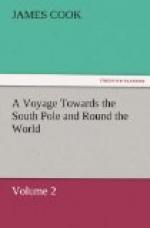1775 June
On the 9th of June at noon we made the island of Fernando de Noronha, bearing S.W. by W. 1/2 W., distant six or seven leagues, as we afterwards found by the log. It appeared in detached and peaked hills, the largest of which looked like a church tower or steeple. As we drew near the S.E. part of the isle, we perceived several unconnected sunken rocks lying near a league from the shore, on which the sea broke in a great surf. After standing very near these rocks, we hoisted our colours, and then bore up round the north end of the isle, or rather round a group of little islets; for we could see that the land was divided by narrow channels. There is a strong fort on the one next the main island, where there are several others; all of which seemed to have every advantage that nature can give them, and they are so disposed, as wholly to command all the anchoring and landing-places about the island. We continued to steer round the northern point, till the sandy beaches (before which is the road for shipping) began to appear, and the forts and the peaked hills were open to the westward of the said point. At this time, on a gun being fired from one of the forts, the Portuguese colours were displayed, and the example was followed by all the other forts. As the purpose for which I made the island was now answered, I had no intention to anchor; and therefore, after firing a gun to leeward, we made sail and stood away to the northward with a fine fresh gale at E.S.E. The peaked hill or church tower bore S., 27 deg. W., distant about four or five miles; and from this point of view it leans, or overhangs, to the east. This hill is nearly in the middle of the island, which no where exceeds two leagues in extent, and shews a hilly unequal surface, mostly covered with wood and herbage.
Ulloa says, “This island hath two harbours capable of receiving ships of the greatest burden; one is on the north side, and the other is on the N.W. The former is, in every respect, the principal, both for shelter and capacity, and the goodness of its bottom; but both are exposed to the north and west, though these winds, particularly the north, are periodical, and of no long continuance.” He further says, that you anchor in the north harbour (which is no more than what I would call a road) to thirteen fathoms water, one-third of a league from shore, bottom of fine sand; the peaked hill above-mentioned bearing S.W. 2 deg. southerly.*
[* See Don Antonio d’Ulloa’s Book, vol. ii. chap. 3. page 95 to 102, where there is a very particular account of this island.]
This road seems to be well sheltered from the south and east winds. One of my seamen had been on board a Dutch India ship, who put in at this isle in her way out in 1770. They were very sickly, and in want of refreshments and water. The Portuguese supplied them with some buffaloes and fowls; and they watered behind one of the beaches in a little pool, which was hardly big enough to dip a bucket in.




